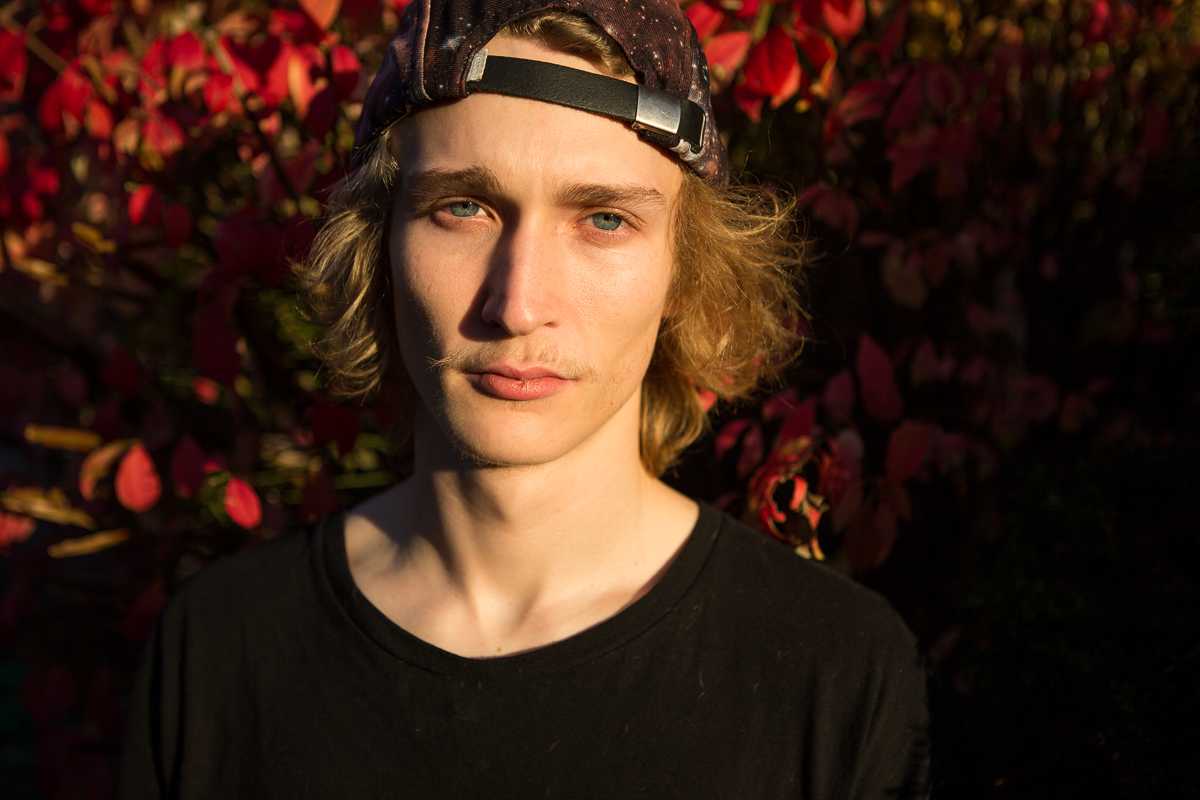Rachael Banks: Exploring the in-between
March 14, 2017
Twice a month for two years, Rachael Banks drove the span of interstate between Dallas, Texas and her hometown of Louisville, Kentucky—books on tape accompanying the routine car rides alone.
The commute was more than 800 miles; she would leave early Thursday morning and arrive in the evening. The time between her drives were spent shooting photographs for her series “Between Home and Here,” which was recently featured in NKU’s School of the Arts’ main gallery.
Banks is also an assistant professor in photography at NKU and lives back in her hometown.
She said that she got into photography as a young teenager when her dad built a darkroom to keep her out of trouble.
Laura Hartford, her mentor at Bellarmine, was a huge influence for her, Banks said. She’s the reason why she decided to teach.
The series also revolves around the idea of both loving and hating where one comes from.
“The work stemmed from feelings of homesickness and guilt for leaving my hometown…so when I moved to Dallas to pursue graduate school, I still had a strong connection to my hometown,” Banks said. “Making the work, before it even became a full-bodied or serious project, was a way for me to see family but also to continue to make work and fill requirements for school.”
Loving and hating where you’re from
Banks said she came from a family and social background that was plagued by alcoholism and drug abuse; though she said they weren’t things she actively participated in, they still formed her identity.
Moving to Dallas, she realized that stereotypes and mythologies associated with being from the Midwest were partially true.
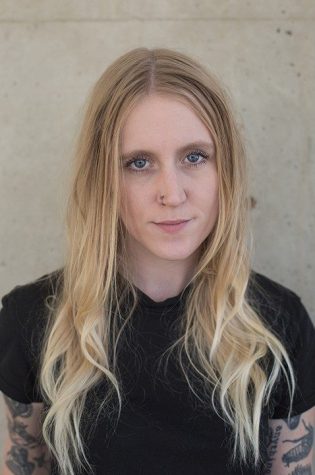
Rachael Banks is an assitant professor at NKU. Her work was recently showcased in SOTA’s main gallery.
“A lot of the things that I didn’t like about the Midwest, ironically enough when I moved were the things that I missed,” Banks said. “I never thought myself as being emotionally attached to a place, but it wasn’t until I left that place that I saw there was an emotional attachment.”
The work in “Between Home and Here” addresses concepts of being attached to people and geographic settings, but also of guilt, love and self-awareness, according to Banks.
As a child, she and her siblings’ lives were often in a state of transition. Her father spent a portion of Banks’ life incarcerated. Her parents had what she called a “volatile” divorce. For two or three years of her life, she didn’t see her father and her mother remarried.
As a result, she said she and her siblings became one another’s support system. When she left for Dallas, she feared what her family and friends would do without her.
“One of the things that came out of the situation, that I noticed—of course, there was this codependency—and the older we got I discovered that it was me that was the codependent one,” Banks said. “I had always, my entire life, had this role and obligation that I felt. It was an assumed obligation, I felt like ‘this is what I’m supposed to do, I have to take care of them no matter what.’”
The older she got, the more Banks said she took on a maternal role with her siblings. Her younger brother, Michael, is 22 and her younger sister, Taylor, is 24.
“The more I went back to the work, it came full circle and I realized that it was me that needed them,” Banks said.
The protagonists
Banks said it took her awhile to realize that the project came from her own need. She was not able to fully let go of her siblings without the feelings of guilt that surrounded her absence.
“A photograph is representative of the failure to let go. It’s the inability to let go of something or to cheat death. If we think of when someone we love dies and how we commemorate that person, a photograph is a way of keeping someone alive,” Banks said. “For me, the photograph was a way to keep people close to me wherever I went, even if they weren’t physically with me. It was also a way to not completely let go of them.”
Though she also took photographs of her half-sisters and friends, she envisioned her siblings as the protagonists of her photo series, which—though the work doesn’t consume her time as much as it once did—is still ongoing.
Out of the three, Banks is the only one to go to college. Her sister works in a gas station and her brother lives with their dad. Her brother dropped out of high school and got a GED, while Banks said her sister barely finished.
“I think that my siblings, while we do have a close bond, there’s also a little bit of this golden child resentment,” Banks said. “Subconsciously, I think they’ve felt like they haven’t had a way to contribute to my life in a valuable way. I think this project has gotten rid of that barrier.”
Previously hanging on the white gallery walls in SOTA, her sister’s freckled presence peered back at transient visitors, viewing the photo series. The picture is printed on vinyl material and her face is outlined by a beige and black faux fur hood.
The background of green leaves brings out the green of her eyes and her pale pink mouth is in a straight line.
Banks said the photograph wasn’t planned and taken outside of her sister’s work.
In another photo, her brother slouches back in a chair, surrounded by potted plants—which parallels with the plants on his tee-shirt. A cigarette is perched between his fingers as he stares sleepily into the camera, and then through the gallery. She said viewers of her art come into the gallery shed of pre-existing notions of who her subjects are as people.
“We always see ourselves differently than the way others see us,” Banks said.
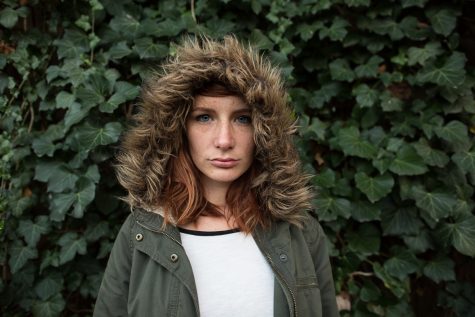
Being a part of a piece of art, in the viewer’s perspective, gives height to a person.
Although she said she started photographing her sister first, Michael was photographed the most frequently. Though she started photographing him in 2014, he didn’t see a photo of himself until about a year and a half ago, Banks said.
“A lot of the people I photograph, a lot of them, I think, have dealt with issues of feeling worthless; but I feel like that’s every person,” Banks said. “I don’t think there’s anybody that has ever not felt bad about themselves. Being described as a work of art or having your likeness projected on a gallery helps combat that feeling of low self-worth.”
Part of what Banks said she loved about being a photographer is that she can look at people as people, rather than viewing them by their circumstance.
Michael, she said, represents this idea of how people are often viewed and judged unfairly based on circumstances out of their realm of control.
“…In terms of background, upbringing and circumstance he has probably endured it the worst out of the three of us—he really got the shit end of it,” Banks said. “To just see the kind of person he is now and to see how’s he’s unfairly judged is something that I’m intrigued by.
“That’s not how I see him.”
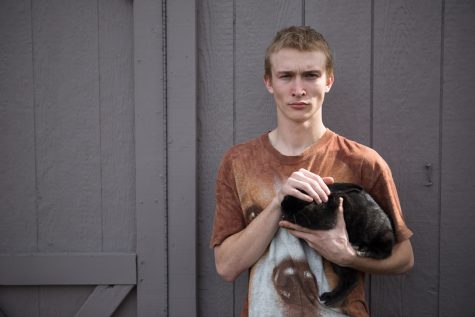
When someone walks into a gallery these notions seem to disappear, she said. She added that it’s been interesting to see that viewers do notice that he has a presence.
“Growing up with an individual who was always told he wouldn’t be anything in life–and then seeing his face on a gallery wall–and people who don’t know him walk into this gallery are intrigued and fascinated by his presence,” Banks said. “They don’t care about if he has a GED or smokes pot or if he didn’t go to school. They don’t care anything about him. A gallery is way to heighten something.”
The problem of domestic birds
Banks had planned a shoot that day. She asked Michael to hold a chicken. Zooming in and focusing the lens on her canon Mark 3, she said that she noticed that he was pouring sweat.
Moments earlier, he was fine.
The memory is concealed in a photograph, which hangs on her wall by her desk in her office.
“I stopped and said ‘What’s wrong with you?’ and he was like, ‘Nothing. I’m fine.’ Then I remembered, he’s terrified of chickens. Horribly, horribly terrified of chickens,” Banks said.
This moment reminds her of her brother’s humbleness. Even if something was bothering him, Banks said she doesn’t think he’d say so.
Her brother is terrified of domestic birds. In the photograph, she pointed out that one can sense that holding the chicken isn’t natural to him. Discomfort underlies his facial features.
She said this moment was problematic not only in that she forgot about her brother’s phobia, but also that she doesn’t want to exploit her subjects.
“The fact that he saw that I had this vision for an image—he might not understand what my art is about conceptually and probably never gives a shit to read my thesis—and he doesn’t feel like he belongs in a gallery—I’m still his sister and he still loves me and will do anything for me,” Banks said. “In that moment, I told him to grab a chicken and hold it and he did it without saying anything about it.”
Banks wants to get as close to making honest photographs as she can.
“Overly staging and directing and making people that I’m close to do things that aren’t natural to them—that’s problematic to me,” Banks said. “It’s not that I’m a purist, but the work is definitely a little more emotional and these are all people that never asked to be photographed, let alone be on public display.”
The emergence of animals
When she was young, Banks recalled her father driving to the middle of nowhere right as the sun was about to go down to watch deer.
They would sit in a tree and feed the deer; though her dad hunted some, she said she that she never saw him kill an animal.
Animals have always been a part of her life and her family’s life. Her dad has five dogs and several chickens. She has three herself, and her sister two dogs and two cats.
“We’ve dealt with so many shitty aspects of life and there’s this general lack of trust toward strangers and people and not as much faith in people, where animals are innocent,” Banks said. “There’s no such thing as an innocent person, and an animal is truly innocent.”
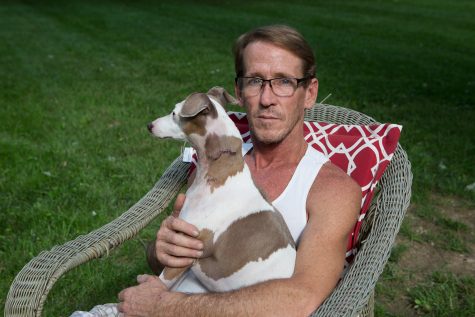
Banks’ father holding his dog, Grady. The photograph is titled “Benson Hurt Grady.” Taken in 2015.
Photographing her subjects holding animals began as an accident but continued to occur more and more frequently in her work.
Banks said animals are also a part of her identity, as well as layer visual geographical cues.
As a whole, most of these photographs are directed and staged. However, Banks said that although she often exaggerates points in her photos, she doesn’t edit much of work or change the environment around her subjects.
“Photos are not objects of truth. Everything is always staged, even if I try to make something as honest as possible, it’s still staged and romanticized or there’s a story to it or exaggerated,” Banks said.
Banks tries not to give herself too many rules because she says it will inhibit her ability to work.
Her first photograph exploring this—which she said was also linked to her interest in surrealism—was of her sister, a snake draped around her shoulder.
“I wrote you a letter, I bought you some flowers.”
When she was a child, Banks said she has a memory that has haunted her. Her dad used to plant flowers everywhere. For each child, he would grow a different flower. For her brother, he planted rose bushes. For her sister, tulips. For her, daisies and snapdragons.
When she was about four or five, there was a courtyard in front of her house covered in rose bushes. She said that there was an opening in the bottom of the bushes that she’d crawl through. In the circle of roses was an opening where she’d go and hide.
“One time, when I climbed through the rose bushes, there was a dead robin in the middle and I was playing with this dead bird and playing with its beak and looking at its anatomy. This memory has always stuck in my head because it’s this metaphor of life and death,” Banks said. “…I’m five years old and I’m sitting in this circle of rose bushes and I’m isolated from the world and I’m playing with a dead bird. It’s this object of taboo.”
The recurrence and symbolism of flowers resulted in the project she is now working on—though still working on “Between home and Here.”
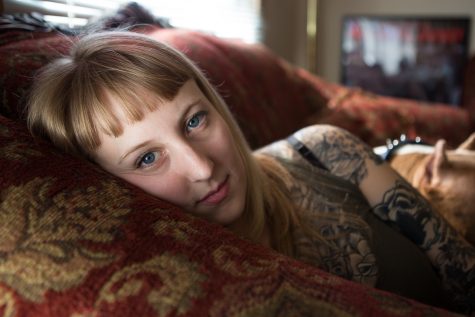
Though Banks said that her siblings were her main subjects, she also took photos of her half-sisters and friends for “Between Home and Here.” Titled “Cecilia,” this was taken in 2015.
“I wrote you a letter, I bought you some flowers,” is more symbolic and conceptual, Banks said, adding that it’s a collection of images from her memory of her childhood and they parallel with other aspects of life.
“I remember the first funeral I went to, and there were flowers everywhere. I started thinking about that, and how it related to death in a way,” Banks said. “We use flowers to celebrate, but also to commentate the dead and hide death.”
She recalled a previous boy she had dated as a teenager. He would sneak into her room at night with push pins and pin flowers to her wall. When she woke up, she’d have a new flower.
Banks noted that flowers seem to repeat in her life, from childhood and on.
The project, which she called her baby, explore concepts of death, rebirth and parallelism. It explores escapism, love, falling out of love and wanting to be a kid again but not being able to.
“It’s about the inevitable,” Banks said. “The inevitable being change and death.”
The project also incorporates letters from and to people she’s close to, doesn’t talk to anymore and letters from her father when he was in jail.
The concept also came back to her when her friends began to OD on heroin, heroin coming from a flower. Heroin also presented itself in “Between Home and Here.”
“If it’s one thing I hate about where I’m from, it’s heroin,” Banks said. In one of her photographs, a heroin needle sits in green grass. The day it was taken it was sunny and she had turned away from her taking pictures of her brother to notice it, sitting in the ground. Banks said it was a reminder that something was always dark and looming.
“When it turned from being one person [overdosing] into 20 people, it’s staring you in the face,” Banks said.
Sad Things
Currently, her house is covered in mason jars stuffed in dead flowers.
When she released the zine “Sad Things,” a self-published booklet of her artwork and photographs, she sent it with flowers that had notes in Ziploc bags.
Flipping through the zine, one would find a hybrid of textual art, Banks’ photography work and letters.
A zine is a homemade or online publication that generally focuses on unconventional subject matter.
In the summer, Banks will teach a zine making course.
“It’s important to me that my art is accessible to anyway. I love the DIY community and making zines because it’s a way to give my art to anybody,” Banks said. “The art I make is important, but it’s never just for me. Once you make art and put it in a gallery, it’s never just for you.”
She added that many of the people she photographs don’t come from a background of fine art or necessarily feel at place in a gallery.
“I don’t think the amount of money someone spends to buy one of the pieces necessarily means that piece of work is more important. There’s a lot of barriers in the art world that can be lowered.”
She added that she doesn’t think that anyone should feel that they don’t belong in an art gallery.
“I don’t think art is for one type of person or group of people,” Banks said. “You don’t have to have a degree to appreciate an image.”

